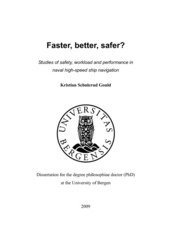| dc.contributor.author | Gould, Kristian Schulerud | en_US |
| dc.date.accessioned | 2009-09-25T06:40:32Z | |
| dc.date.available | 2009-09-25T06:40:32Z | |
| dc.date.issued | 2009-09-04 | eng |
| dc.identifier.isbn | 978-82-308-0855-9 (print version) | en_US |
| dc.identifier.uri | https://hdl.handle.net/1956/3484 | |
| dc.description.abstract | Ship navigation in the Royal Norwegian Navy (RNoN) involves high demands on navigators, who are required to work under a number of dangers. Operations are carried out in poor weather and darkness, at day and night, in restricted waters, and at high speeds. Accidents are frequent, and sometimes serious. Currently, the RNoN is in the process of replacing its Hauk-class fast patrol boats with the new Skjold-class littoral combat ship. Fast patrol boats play an important role in Norway’s coastal defence. Since this transition will involve a major change in manning levels and task characteristics, it is expected to have a considerable impact on the navigator’s demands. The aims for this project were to a) examine the situation characteristics of past navigation accidents in the RNoN, and b) investigate the consequences of the Hauk-Skjold transition on workload and performance in navigation. This was accomplished through three individual studies. The first study in this project examined the presence of performance-shaping factors in investigation reports following 35 navigation accidents in the Royal Norwegian Navy between 1990 and 2005. This was done to provide an overview of the situation characteristics present at the time of the accidents, related to either the human, task, system or environment. Performance-shaping factors (PSFs) are defined as any factors which influence the likelihood of an error occurring. Factors related to task requirements and individual cognitive characteristics were shown to be most common, followed by operational characteristics of the system. Eight PSF clusters were found, indicating a pattern in accident circumstances. It was shown that accidents almost always have a high number of different factors influencing accident risk. The second study examined mental workload and performance in simulated high-speed ship navigation. Two navigations methods were compared; these were based on electronic chart display and information system (ECDIS) and a conventional system using paper charts. Twenty naval cadets navigated in high-fidelity simulators through 50 nautical mile-courses with varying levels of difficulty. Results showed that ECDIS navigation significantly improved course-keeping performance, and reduced the total amount of communication on the bridge. No differences were observed in subjective workload between the two groups. Heart rate variability and skin conductance measurements did indicate higher sympathetic activation in conventional navigation, but the differences between groups were not statistically significant. The third and final study in this project investigated how workload and performance in high-speed ship navigation was affected by sleep deprivation, using two different navigation methods. In two separate weeks, five navigators sailed through ten 55-minute routes in high-fidelity simulators, while undergoing 60 hours total sleep deprivation. Navigation performance was measured in addition to subjective and psychophysiological indices of workload and sleepiness. Results showed that navigation performance again was significantly better in the electronicchart condition, but was largely unaffected by sleep deprivation in both conditions. At the same time, there was significant interaction between speed, sleep deprivation and navigation method, indicating that navigators using electronic charts reduced their speed proportionally more under periods of high sleepiness. Secondary task performance was significantly reduced by sleep deprivation, but was equally affected in both conditions. Mental workload was significantly higher in the electronic-chart condition, as indicated by subjective ratings and heart rate variability. No significant differences in sleepiness were found between navigation methods, but electroencephalographic recordings indicated a higher incidence of sleep episodes in the electronic-chart condition after 52 hours of sleep deprivation. This possible risk may have been influenced by significantly lower overall arousal (indicated by lower sympathetic activation) in the electronic-chart condition. | en_US |
| dc.language.iso | eng | eng |
| dc.publisher | The University of Bergen | eng |
| dc.relation.haspart | Paper I: Military Psychology 18(3S), Gould, K. S.; Røed, B. K.; Koefoed, V. F.; Bridger, R. S.; Moen, B. E., Performance-Shaping Factors Associated With Navigation Accidents in the Royal Norwegian Navy, pp. S111–S129. Copyright 2006 Lawrence Erlbaum Associates, Inc. Published by Taylor & Francis. Full text not available in BORA due to publisher restrictions. The published version is available at: <a href="http://dx.doi.org/10.1207/s15327876mp1803s_9" target="blank"> http://dx.doi.org/10.1207/s15327876mp1803s_9</a> | en_US |
| dc.relation.haspart | Paper II: Applied Ergonomics 40(1), Gould, K. S.; Røed, B. K.; Saus, E. R.; Koefoed, V. F.; Bridger, R. S.; Moen, B. E., Effects of navigation method on workload and performance in simulated high speed ship navigation, pp. 103-114. Copyright 2008 Elsevier Ltd. Full text not available in BORA due to publisher restrictions. The published version is available at: <a href="http://dx.doi.org/10.1016/j.apergo.2008.01.001" target="blank"> http://dx.doi.org/10.1016/j.apergo.2008.01.001</a> | en_US |
| dc.relation.haspart | Paper III: Gould, K. S.; Hirvonen, K.; Koefoed, V. F.; Røed, B. K.; Sallinen, M.; Holm, A.; Bridger, R. S.; Moen, B. E., 2009, Effects of 60 Hours of Total Sleep Deprivation on two Methods of High-Speed Ship Navigation. Full text not available in BORA. | en_US |
| dc.title | Faster, better, safer? Studies of safety, workload and performance in naval high-speed ship navigation | en_US |
| dc.type | Doctoral thesis | |
| dc.rights.holder | Kristian Schulerud Gould | |
| dc.subject.nsi | VDP::Medisinske Fag: 700::Helsefag: 800::Andre helsefag: 829 | nob |
| dc.subject.nsi | VDP::Medisinske Fag: 700::Helsefag: 800::Samfunnsmedisin, sosialmedisin: 801 | nob |
